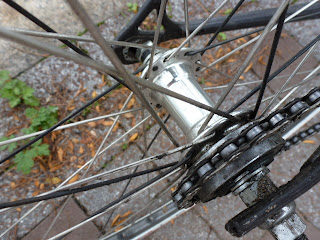I've made a change to the Trek 560 I recently built.
As you may recall from earlier posts, I'd equipped the bike with a Velosteel rear coaster brake hub. Well, I swapped it for a single speed rear hub.
I might use the Velosteel hub on another bike, perhaps an old mixte or mountain bike. I hadn't quite gotten used to its idiosyncrasies They include the "dead" pedal stroke of half a pedal revolution I experienced when I started pedaling again after braking and that when I backpedaled, it seemed that the hub had to find its "sweet spot" before the brake engaged. (Other coaster brakes I've ridden would stop the bike as soon as I backpedaled.) I suppose that if I rode the hub more (I put about 200 miles on it.) I'd get used to it.
But even if I were to grow accustomed to, and like, riding with the hub, I don't think I would have wanted to keep it on the Trek--assuming, of course, I decide to keep the Trek. It's a good bike, but a little bit too large for me. Plus, for a winter/beater bike, I think I'd rather have something that can accept wider tires.
One thing you might have noticed is that some of the spokes are silver and some are black.
I didn't plan it that way: It just happened that I had 28 silver and 12 black spokes in the length I needed, and the wheel needed 36 spokes. I used all of the black spokes and 24 of the silver ones. So, every third spoke is black.
Somehow I think that might actually be a selling point!











